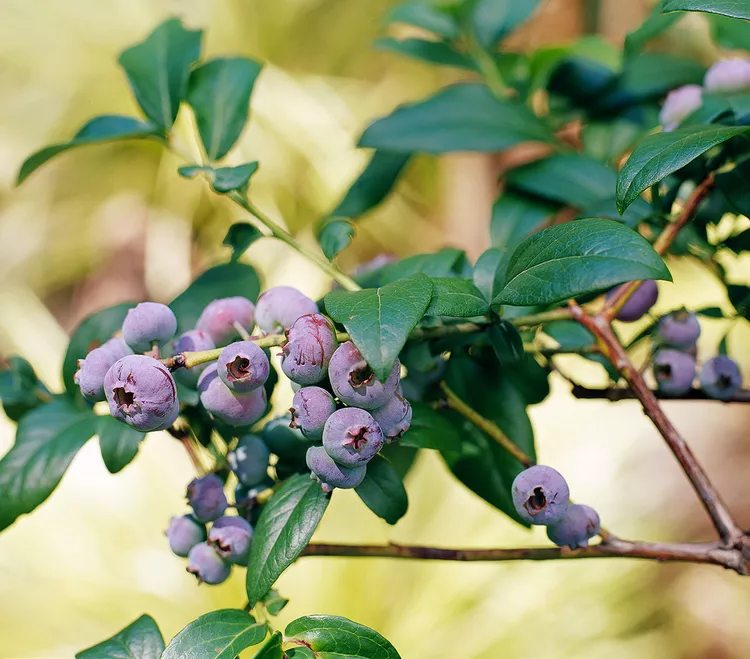Blueberries are among the easiest, tastiest fruits you can grow in your backyard. These multi-stemmed, deciduous shrubs grow to different heights depending on the type. Unpruned highbush blueberries (Vaccinium corymbosum) will grow six to eight feet, rabbiteye varieties (Vaccinium ashei) may reach 15 feet, and lowbush types (Vaccinium angustifolium) top out at two feet tall. Besides keeping the taller types within reach for easier harvesting, you’ll get more and better berries if you keep them pruned. Blueberries produce their best fruit on growth from the previous season (one year old wood). Older stems produce less fruit and it’s usually smaller.
When Should You Prune Blueberries?
Pruning should be done while the plants are dormant. This could be any time after leaf drop to late winter. However, many growers, particularly in colder regions, prefer to wait until late winter.
Most blueberry plants don’t need to be cut back at all at planting time. However, if they have weak or broken stems, these should be removed. As difficult as it may be to do, you should remove all flower buds on new plants (these are visible in late winter and can simply be rubbed off). This helps the plants channel their energy into vegetative growth which, in the long run, means healthier, more productive plants.
Tools for Pruning Blueberries
Hand pruners are good for most cuts. But for older, larger branches you’ll need loppers that can cut stems two inches in diameter. Always make clean cuts without tearing the bark, and try not to leave any stumps.
Pruning Highbush and Rabbiteye Blueberries
During the two years following planting, minimal pruning is required for highbush or rabbiteye blueberry bushes. Your focus should be on developing healthy well-established plants, so simply examine your plants and remove any stems that are weak or crossing over each other. Don’t let your plants bear more than a few clusters of fruit until they're at least three years old. If you encourage them to produce fruit earlier, they’ll be less productive in the following years.
Three- to four-year-old plants should have reached sufficient size to start bearing respectable crops. At this stage of maturity, pruning blueberry plants annually when they’re dormant is the key to enjoying steady harvests from one year to the next. Because one-year-old wood bears your best fruit, you want to encourage plenty of new growth every year for the following year’s crop. If blueberries are not pruned annually, they sometimes fall into a biennial bearing habit, and you’ll only get a crop every other year.
As with young blueberry plants, remove all weak and crossing branches. Also remove any stems that are very close to the ground because fruit that would form on them is more prone to diseases splashed up from the soil. Remove up to one third of the oldest canes—the largest, grayest ones—cutting them all the way back to the ground. These old canes become unproductive; removing them opens up the center to air and light and stimulates new shoots that will bear the next year’s crop. Cut taller stems to the height you desire, making the cut just above a bud or side stem. Thin out the remaining stems by removing those that are spindly, leaving the stronger, thicker stems to produce the berries.
Renewing Old Blueberries by Pruning
If you’re lucky enough to inherit existing highbush or rabbiteye blueberry plants when you buy a house, it’s a good idea to look them over carefully to see that they are up to date with their pruning regime. Plants that have been neglected can be resurrected, but they will need serious renewal pruning. This involves removing all dead, diseased wood, crossing stems, and low hanging branches. Cut the old canes back to the ground. Look for and remove suckers that may have sprouted some distance from the main plant.
Once you have a basic framework, begin to cut back stems to the desired height, cutting them back to an upward facing bud or branch. Remove or cut back some of the lateral stems if necessary to open up the center to allow good air circulation.
Pruning Lowbush Blueberries
Lowbush blueberries are grown primarily in the Northeast United States and eastern Canada where winters are cold, but they can be grown elsewhere. This native shrub is more of a groundcover, growing only one to two feet tall; it spreads by both seed and rhizomes to form dense patches.
Unlike other types of blueberries, lowbush varieties can be mowed to the ground. The plant quickly regenerates the following season, but it will take two years after mowing to bear fruit. To get an annual crop, you should divide your planting in half and mow one half every other year.
In a nutshell, pruning blueberries mostly involves removing weak and unproductive branches, keeping the center uncongested, and maintaining a manageable height. The result is easier harvesting of bigger and better berries.




















